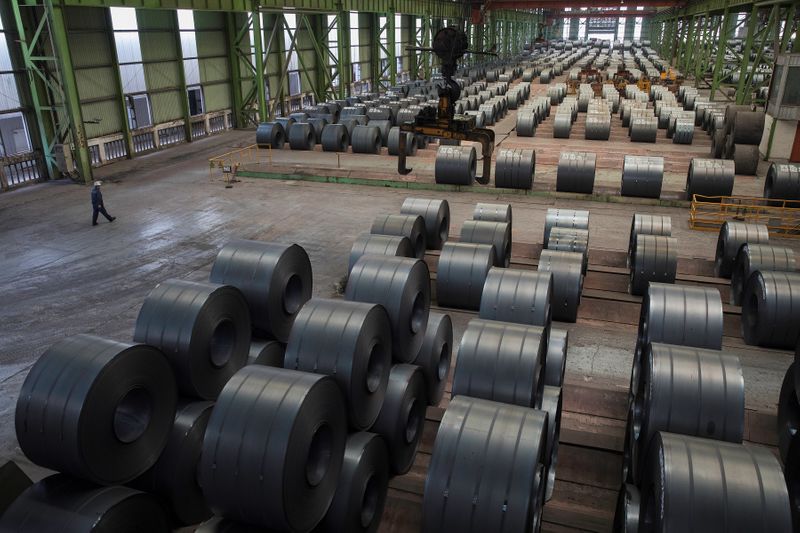By Enrico Dela Cruz and Min Zhang
MANILA/BEIJING (Reuters) - Behind the boom in China's steel production since March - and hopes for a quick economic recovery - is a tale of two diverging sectors: construction demand for infrastructure projects has been strong, while manufacturing has been slower to bounce back.
That highlights the challenge facing policymakers as Beijing and local governments can control the pace of spending on projects like roads, rails and reservoirs, but have very limited options to support exports or domestic demand for machinery and appliances.
The soft underbelly in China's steel revival following the coronavirus outbreak is about to be thrown into stark relief by a seasonal downturn at building sites, analysts say, and points to a more protracted recovery for the world's second-largest economy from a once-in-a-century pandemic.
"There is only so much China's steel industry can do while the rest of the world struggles," said Daniel Hynes, senior commodity strategist at ANZ.
CRITICAL COG
China's mammoth steel sector has long been a central pillar of its industrial powerhouse, employing hundreds of thousands of workers who churn out vital raw materials for industry and support scores of ancillary logistics and processing businesses.
The economy shrank 6.8% in the first quarter, the first contraction in decades, hit by the new coronavirus which emerged in China late last year.
The surge in steel output to all-time highs in May raised hopes that the heart of the economic engine is recovering well, and may help resuscitate growth at home and globally.
Yet amid the recent sector-wide bustle has been a lopsided reliance on metal demand from construction sites that has partially masked weakness from manufacturers and calls into question the robustness of the steel boom as well as how quickly China can restore growth.
(Graphic: China's GDP vs crude steel output - https://fingfx.thomsonreuters.com/gfx/ce/yzdvxdlmzvx/Annotation%202020-06-19%20115357.jpg)
"The market appears to be relying too heavily on expected infrastructure stimulus in China to boost demand," ANZ's Hynes said.
REBAR RELIANCE
Demand for the main steel products used in construction - rebar and wire rod - has accounted for an average over 53% of total steel demand since late March, according to calculations based on figures from data-tracking firm Mysteel.
That compares to an average of 47.5% for all of 2019, and 51% for the same period in 2019.
(Graphic: Seasonal steel demand by product in China - https://fingfx.thomsonreuters.com/gfx/ce/nmovakealva/SeasonalSteelDemand2020.png)
At the same time, demand for the main steel products used by manufacturers - hot-rolled coil (HRC) and cold-rolled coil (CRC) - has been well below normal, averaging 35% of total demand since late March compared to 40.4% on average in 2019.
Stocks of rebar have also fallen faster than other steel products, dropping by 51% since peaking in mid-March.
(Graphic: Seasonal steel stocks by type in China - https://fingfx.thomsonreuters.com/gfx/ce/gjnvwymdbvw/SeasonalSteelStocks2020.png)
Given the extent of lockdowns in many of China's trading partners, sluggish factory demand is not too surprising and could persist for many more months.
Yet the surge in overall steel production - driven by a 59% jump in rebar and 40% rise in wire rod output since mid-March - suggests the sector is at risk of over-supplying the market just as demand is expected to take a hit from rained-out work sites, especially across the South.
(Graphic: Seasonal steel production by type - https://fingfx.thomsonreuters.com/gfx/ce/dgkvlwnyxpb/SeasonalSteelOutput2020.png)
The monsoon season, which runs through August, arrived 10 days earlier than normal in southern China this year, causing widespread floods that have already stopped work at some sites.
"We are now about to enter the traditional slack season for steel consumption," said Richard Lu, senior analyst at consultancy CRU in Beijing. "It will largely depend on the weather, and we should see some decline at least starting from July, if not late June."
(Graphic: China steel vs iron ore futures prices - https://fingfx.thomsonreuters.com/gfx/ce/gjnvwydglvw/612c.jpg)
The most-active rebar
DEMAND DEPRESSION
While construction materials are losing demand momentum, flat steel use has been plagued by the global economic contraction and that has kept China's factories underpowered.
Sales of steel-heavy items like autos and machines have fallen this year, with China's auto exports dropping 16.9% in the first five months, and home appliance exports - worth $77.8 billion (62.97 billion pounds) in 2019 - down 9.1%.
Direct metal exports have also dropped.
(Graphic: Exports of home appliances from China - https://fingfx.thomsonreuters.com/gfx/ce/oakpeqwznpr/612e.jpg)
STIMULUS TEST
To offset lower global demand China's policymakers have unveiled stimulus measures aimed at reviving consumption and supporting large infrastructure projects including key industries.
(Graphic: Monthly output for main home appliances in China - https://fingfx.thomsonreuters.com/gfx/ce/xlbvggerdvq/612d.jpg)
However, the uneven steel demand shows the limits of Beijing's stimulus, which comes with its own risks, and points to a bumpy economic recovery.
"The Chinese government does not want to spend a lot on stimulating the economy because that also means having to pile up debts," said Iris Pang, ING chief economist for Greater China.
